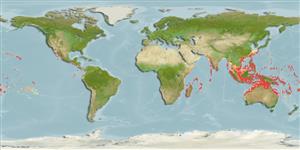Common names from other countries
Environment: milieu / climate zone / depth range / distribution range
Ecologia
marinhas associadas(os) a recifes; não migratória; intervalo de profundidade 5 - 135 m (Ref. 90102), usually 5 - 20 m (Ref. 58302). Tropical; 30°N - 30°S
Indo-Pacific: East Africa to the Galapagos Islands, north to Ryukyu and Hawaiian islands, south to Australia and the Tuamoto Islands.
Tamanho / Peso / Idade
Maturity: Lm ? range ? - ? cm
Max length : 10.0 cm TL macho/indeterminado; (Ref. 4313)
Espinhos dorsais (total) : 12; Raios dorsais moles (total) : 8 - 11; Espinhos anais: 3; Raios anais moles: 5 - 6. Tan to reddish or brown in color (Ref. 4313). Has prickly papillae instead of scales. Dorsal fin high, 3rd or 4th spine longest; suborbital ridge without spines or with lump at head of ridge; preopercle with 2 indistinct spines only; body extremely compressed; soft dorsal fin attached to the caudal fin; coloration is variable, from nearly all yellow to red, brown or nearly black and variously mottled with darker pigment (Ref. 10482).
Inhabits reef flats, outer reef slopes, current-swept channels, and rarely on lagoon reefs (Ref. 1602). Benthic (Ref. 58302). Solitary and usually immobile among algae or seagrass but effects hip movements resembling that of a leaf falling down from a tree. Molts twice a month with the skin breaking off first in the head region. Has the habit of mimicking a dead leaf by swaying from side to side (Ref. 37816). Feeds on small crustaceans and fishes (Ref. 9710); also feeds on larvae (Ref. 5503). Venomous spines.
Life cycle and mating behavior
Maturities | Reprodução | Spawnings | Egg(s) | Fecundities | Larvas
Myers, R.F., 1991. Micronesian reef fishes. Second Ed. Coral Graphics, Barrigada, Guam. 298 p. (Ref. 1602)
Categoria na Lista Vermelha da IUCN (Ref. 130435)
CITES (Ref. 128078)
Not Evaluated
Utilização humana
Can't connect to MySQL database (fbapp). Errorcode: Too many connections
